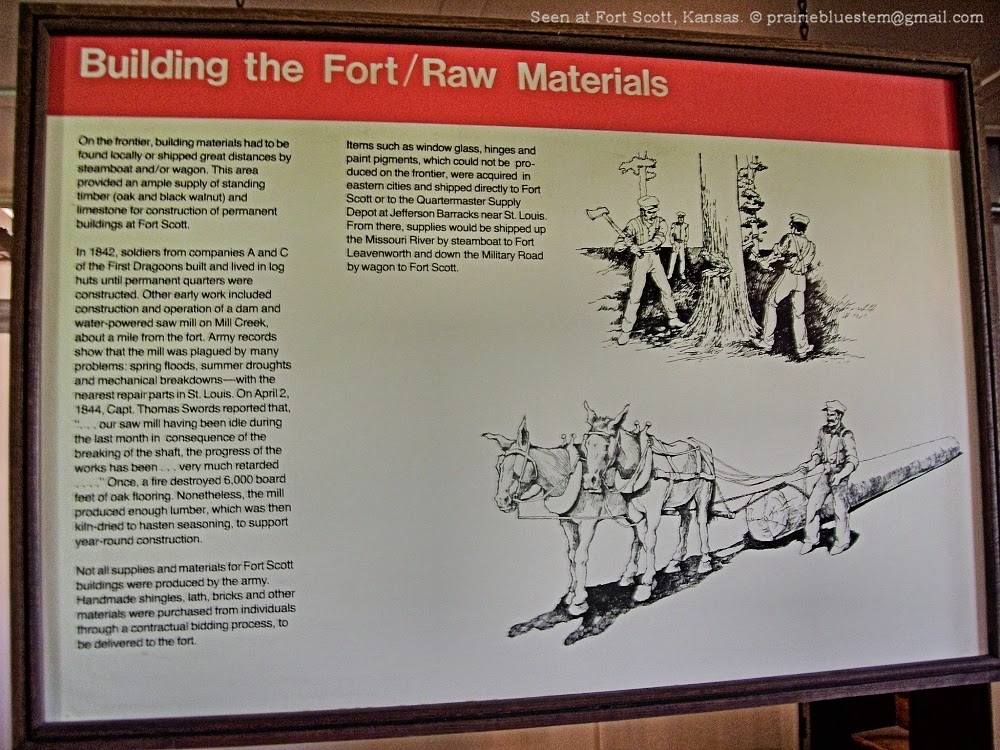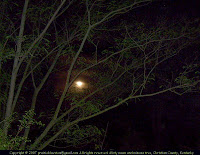1840s at Fort Scott, Kansas
We visited the national historic site at Fort Scott, Kansas, last week on our way back to Kentucky. I wanted to tour the fort because I think my 4th great-grandfather John Hill spent a short time there as a private in the 4th Infantry, Company C. They were stationed at Fort Scott from 1842 through mid-1845.
John Hill enlisted in late April of 1845, and the 4th Infantry, Company C, left Fort Scott and headed for Texas in late July of 1845. So John probably didn't spend much time at Fort Scott, but he probably did join up with Company C there.
Captain MacRae had been recruiting in eastern Ohio, and that's where John Hill signed up. Captain MacRae probably escorted John and the other recruits back to Company C. They probably made most of the trip from eastern Ohio to eastern Kansas by water. By 1845, steamboats were on all the big rivers. They could have taken a steamer down the Ohio River to the Mississippi, then another one to St. Louis and yet another one up the Missouri River to Fort Leavenworth. From Fort Leavenworth down to Fort Scott, they may have -- walked? They
were infantry, after all. That was probably their first march.
Important disclaimer:
I think this John Hill was my ancestor John Hill because:
a) this John Hill was born in the right place to be my John Hill;
b) this John Hill enlisted in the Army in the town where my John Hill's father lived;
c) this John Hill was the same age as my John Hill; and
d) my John Hill did serve during the Mexican War.
However, there is always a chance that that I have the wrong military record, and this is some other John Hill entirely who was no relation to me at all. There were plenty of John Hills in eastern Ohio. |
Fort Scott was established near the Kansas/Missouri border in 1842, as headquarters for several companies of dragoons. The dragoons had several missions: keeping land-hungry settlers out of Indian territory, guarding the military road that ran from Fort Leavenworth into Oklahoma, surveying the land so it could be mapped, and more. The fort was abandoned in 1853 because the frontier had moved farther west and a military presence at Fort Scott was no longer important.
 |
"Dragoons" is an old word for mounted soldiers or cavalry.
The photos below show the text of this mural. |
 |
| The stables (left) and dragoons' barracks (right) |
The infantry at Fort Scott didn't go on patrol with the dragoons. They did much of the construction of the fort's buildings, took their turns at a number of routine chores around the fort (including bread-making), practiced their military skills such as marching and handling weapons, and maintained a state of readiness.
 |
The bakehouse was located in a distant
corner so if it caught fire, it wouldn't
burn down the entire fort! |
The boredom that the infantry suffered is mentioned in every account I've read of life at Fort Scott. Hunting was a way to pass the time, as was drinking in the saloons that sprang up outside the compound. But the easy life ended for 4th Infantry, Company C -- those soldiers marched to Texas to serve under General Zachary Taylor and then fought in the Mexican War. John Hill and the other new recruits wouldn't have had much time to learn the soldiering aspects of their new lives before the march to Texas began.
 |
| The infantry, preparing to leave for Texas in 1845 |
 |
Rachel at the infantry barracks.
This building is a reconstruction, though
many of the buildings are originals. |
During the Civil War, Union troops took up residence again at Fort Scott. I didn't pay much attention to the Civil War side of Fort Scott's history. I was more interested in what John Hill might have seen or done.
 |
This exhibit contained the two photographs below.
John Hill might have seen these structures at Fort Scott. |
 |
The powder magazine at center, with lightening rod. At left,
dragoon barracks, and behind the flag, officer's quarters.
At far right, the fort's well, protected by a canopy. |
 |
| A closer look at the dragoon barracks. |
Fort Scott was laid out by a West-Point-educated Army quartermaster named Captain Swords who was at the frontier outpost from 1842-1846. The following is quoted from an information board at the site:
In the four years he served at Fort Scott, Captain Swords designed and had constructed four sets of officers quarters, three barracks, the hospital, the guardhouse, the well canopy, the magazine, the stables, both the ordnance and post headquarters, and the quartermaster warehouse. His plans featured porches to provide shelter from the torrid summers of the plains, large windows for light and air, plastered walls, and graceful stairways. Despite restrictions on hiring, Swords obtained civilian brick layers, platerers, and a stone cutter to help finish the buildings. In 1846, General Kearney promoted Captain Swords to Quartermaster of the Army.
 |
The route that John Hill took to Fort Scott was probably the
same route that building materials took, as described here.
|
 |
These floors are laid on top of three or more layers of rock!
I suppose these super-reinforced floors were Captain Swords' idea. |
The hospital at Fort Scott is now the visitor's center for the site. There, you can pick up a walking-tour brochure, watch a movie, and look at a number of exhibits. It's really nice that the entire site can be visited free of charge.
 |
| The hospital was built in 1843, and this is the original structure. |
 |
Old photo of the hospital
from one of the exhibits. |
I wasn't sure if the buildings were furnished in 1840s or 1860s style, but it was interesting to walk through many of them and see the rooms. Here are some interior photos at the dragoon barracks.
And the quarters, where Captain Swords and his fellow officers lived. I am sure that John Hill never saw these rooms! The enlisted men were forbidden even to stroll the walkways in front of officers quarters.
 |
| This fancy dining room was used only for official entertaining. |
Below, a look inside the quartermaster's building (work headquarters for Captain Swords):
And lastly, some flowers that were growing behind one of the buildings. I don't know if the soldiers would have had flower beds, but these
are some nice "old-timey" flowers.
If you'd like to read more about Fort Scott, the
official website is packed with information and nice photos.




















